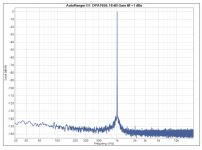Maybe I'm too thick, but I still don't get it.
Assuming proper design, VGS1a - VGS1b is a random variable with zero mean. Presumably its temperature dependence is also a random variable with zero mean; when transistors 1a and 1b match perfectly, there is no offset and no temperature dependence, when VGS1a is greater than VGS1b you get a temperature dependence in one direction and when VGS1b is greater than VGS1a you get a temperature dependence in the other direction.
Similarly, assuming proper design, VGS2a - VGS2b is a random variable with zero mean. Presumably its temperature dependence is then also a random variable with zero mean.
If the temperature dependencies of VGS1a - VGS1b and VGS2a - VGS2b are independent random variables with zero mean, then how can keeping all four transistors at the same temperature cancel anything at all?
Assuming proper design, VGS1a - VGS1b is a random variable with zero mean. Presumably its temperature dependence is also a random variable with zero mean; when transistors 1a and 1b match perfectly, there is no offset and no temperature dependence, when VGS1a is greater than VGS1b you get a temperature dependence in one direction and when VGS1b is greater than VGS1a you get a temperature dependence in the other direction.
Similarly, assuming proper design, VGS2a - VGS2b is a random variable with zero mean. Presumably its temperature dependence is then also a random variable with zero mean.
If the temperature dependencies of VGS1a - VGS1b and VGS2a - VGS2b are independent random variables with zero mean, then how can keeping all four transistors at the same temperature cancel anything at all?
Presumably its temperature dependence is also a random variable with zero mean;
This is an incorrect assumption. Offset depends on absolute temperature, as indicated, through the carrier mobility (MOSFET) or intrinsic carrier concentration (bipolar). It is called offset drift and is characterized by a temperature coefficient usually called TCVos. Some op amps do specify a max offset over the entire temperature range, which is less useful, since it does not guarantee that TCVos is constant or even monotonic.
There is no zero offset at all temperatures.
Marcel, if the device physics explanations and the sketchy math above doesn't make sense to you, then I'm afraid I have nothing else to add here. There is a huge literature around "offset drift", you may want to check some more authoritative documents from TI and AD.
Marcel, if the device physics explanations and the sketchy math above doesn't make sense to you, then I'm afraid I have nothing else to add here. There is a huge literature around "offset drift", you may want to check some more authoritative documents from TI and AD.
Output impedance at low frequencies tends to decrease as frequency increases because the compensation capacitor creates a local loop around the output stage, reducing its output impedance.
Clear. Thanks John.
if one of you guys could pony up and buy a million of them, I could have one of my teams try it out!
I started to type 'make me an offer I can't ...' then thought the better of it ;-)
Jan
Do you guys have an idea where to by good opa1656 DIP8?
https://www.ti.com/tool/DIP-ADAPTER...en&hqs=hpa-pa-amp-opa192-dipadapter-evm-pr-en
yes, yes... just understood that it was made more for loads below 1k or 2.5k hz and there are also audio aops they developped especially to drive amps and preamps. But indeed it has no problem in buffer application and it seems to sounds great in all sort of DACs 
Just to know if there are some else good aops at TI as they are very active.
Just to know if there are some else good aops at TI as they are very active.
https://www.mouser.com/ProductDetail/Texas-Instruments/OPA1656IDR?qs=vLWxofP3U2ztlJVp%252BbIcnQ%3D%3DDo you guys have an idea where to by good opa1656 DIP8?
+
30pcs SOP8 SO8 SOIC8 TSSOP8 MSOP8 to DIP8 Adapter PCB DIY Conveter Board new N65 | eBay
+
https://www.amazon.com/gp/product/B00Y80U9C2/ref=ppx_yo_dt_b_asin_title_o00_s00?ie=UTF8&psc=1
+
https://www.mouser.com/ProductDetail/Mill-Max/110-47-308-41-001000?qs=%2Fha2pyFaduieQhp8y8leBf%252BDArkWa%2FCo1B%2F%2Fw6PtM4A8ehULhJSLuOKx9CN8xlhl
Last edited:
That is a darned impressive measurement Jan. Of a very impressive device!
Not my measurement, but yes it is pretty good ;-)
Jan
Opamps are done. Just get a '1656 and be quiet ;-)
This is from an upcoming piece.
Jan
You may happy, I am not, while it is a dual opamp with unknown channel cross-talk behavior given as -120dB... so would wait for a OPA1655 as TI promised to build... also the channel cross talk cannot be simulated, a pitta.
Better in this regard, on noise figures & as also shown with simulation, is the OPA827 (single opamp) cost some more but for measurements a must have IMHO.
Unknown is the given TI simulation model (827 & 1656) against the real implementation, but for sure the noise figure is for the OPA827 much better.
BTW: is this measurement balanced or non-balanced input?
Hp
- Home
- Vendor's Bazaar
- OPA1656: High-Performance CMOS Audio Op Amp
